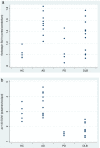PET imaging of amyloid with Florbetapir F 18 and PET imaging of dopamine degeneration with 18F-AV-133 (florbenazine) in patients with Alzheimer's disease and Lewy body disorders
- PMID: 24716655
- PMCID: PMC4027995
- DOI: 10.1186/1471-2377-14-79
PET imaging of amyloid with Florbetapir F 18 and PET imaging of dopamine degeneration with 18F-AV-133 (florbenazine) in patients with Alzheimer's disease and Lewy body disorders
Abstract
Background: Biomarkers based on the underlying pathology of Alzheimer's disease (AD) and Dementia with Lewy Bodies (DLB) have the potential to improve diagnosis and understanding of the substrate for cognitive impairment in these disorders. The objective of this study was to compare the patterns of amyloid and dopamine PET imaging in patients with AD, DLB and Parkinson's disease (PD) using the amyloid imaging agent florbetapir F 18 and 18F-AV-133 (florbenazine), a marker for vesicular monamine type 2 transporters (VMAT2).
Methods: Patients with DLB and AD, Parkinson's disease (PD) and healthy controls (HC) were recruited for this study. On separate days, subjects received intravenous injections of florbetapir, and florbenazine. Amyloid burden and VMAT2 density were assessed quantitatively and by binary clinical interpretation. Imaging results for both tracers were compared across the four individual diagnostic groups and for combined groups based on underlying pathology (AD/DLB vs. PD/HC for amyloid burden and PD/DLB vs. AD/HC for VMAT binding) and correlated with measures of cognition and parkinsonism.
Results: 11 DLB, 10 AD, 5 PD, and 5 controls participated in the study. Amyloid binding was significantly higher in the combined AD/DLB patient group (n = 21) compared to the PD/HC groups (n = 10, mean SUVr: 1.42 vs. 1.07; p = 0.0006). VMAT2 density was significantly lower in the PD/DLB group (n = 16) compared to the AD/ HC group (n = 15; 1.83 vs. 2.97; p < 0.0001). Within the DLB group, there was a significant correlation between cognitive performance and striatal florbenazine binding (r = 0.73; p = 0.011).
Conclusions: The results of this study show significant differences in both florbetapir and florbenazine imaging that are consistent with expected pathology. In addition, VMAT density correlated significantly with cognitive impairment in DLB patients (ClinicalTrials.gov identifier: NCT00857506, registered March 5, 2009).
Figures


Similar articles
-
Clinicopathological Correlation: Dopamine and Amyloid PET Imaging with Neuropathology in Three Subjects Clinically Diagnosed with Alzheimer's Disease or Dementia with Lewy Bodies.J Alzheimers Dis. 2021;80(4):1603-1612. doi: 10.3233/JAD-200323. J Alzheimers Dis. 2021. PMID: 33720879 Free PMC article.
-
Differential diagnosis in Alzheimer's disease and dementia with Lewy bodies via VMAT2 and amyloid imaging.Neurodegener Dis. 2012;10(1-4):161-5. doi: 10.1159/000334535. Epub 2012 Jan 17. Neurodegener Dis. 2012. PMID: 22261520
-
Florbetapir (18F) for brain amyloid positron emission tomography: highlights on the European marketing approval.Alzheimers Dement. 2014 Oct;10(5 Suppl):S395-9. doi: 10.1016/j.jalz.2013.09.007. Epub 2014 Jan 10. Alzheimers Dement. 2014. PMID: 24418060
-
Florbetapir (18F), a PET imaging agent that binds to amyloid plaques for the potential detection of Alzheimer's disease.IDrugs. 2010 Dec;13(12):890-9. IDrugs. 2010. PMID: 21154149 Review.
-
Positron emission tomography radiopharmaceuticals for imaging brain Beta-amyloid.Semin Nucl Med. 2011 Jul;41(4):283-99. doi: 10.1053/j.semnuclmed.2011.02.005. Semin Nucl Med. 2011. PMID: 21624562 Review.
Cited by
-
Imaging the role of amyloid in PD dementia and dementia with Lewy bodies.Curr Neurol Neurosci Rep. 2014 Aug;14(8):472. doi: 10.1007/s11910-014-0472-6. Curr Neurol Neurosci Rep. 2014. PMID: 25011528 Review.
-
Regional brain amyloid-β accumulation associates with domain-specific cognitive performance in Parkinson disease without dementia.PLoS One. 2017 May 25;12(5):e0177924. doi: 10.1371/journal.pone.0177924. eCollection 2017. PLoS One. 2017. PMID: 28542444 Free PMC article.
-
CSF Biomarkers and Its Associations with 18F-AV133 Cerebral VMAT2 Binding in Parkinson's Disease-A Preliminary Report.PLoS One. 2016 Oct 20;11(10):e0164762. doi: 10.1371/journal.pone.0164762. eCollection 2016. PLoS One. 2016. PMID: 27764160 Free PMC article.
-
Florbetaben for PET Imaging of Beta-Amyloid Plaques in the Brain.Neurol Ther. 2014 Nov 27;3(2):79-88. doi: 10.1007/s40120-014-0022-9. eCollection 2014 Dec. Neurol Ther. 2014. PMID: 26000224 Free PMC article. Review.
-
18F PET with florbetapir for the early diagnosis of Alzheimer's disease dementia and other dementias in people with mild cognitive impairment (MCI).Cochrane Database Syst Rev. 2017 Nov 22;11(11):CD012216. doi: 10.1002/14651858.CD012216.pub2. Cochrane Database Syst Rev. 2017. PMID: 29164603 Free PMC article.
References
-
- Barker WW, Luis CA, Kashuba A, Luis M, Harwood DG, Lowenstein D, Waters C, Jimison P, Shepherd E, Sevush S, Graff-Radford N, Newland D, Todd M, Miller B, Gold M, Heilman K, Doty L, Goodman I, Robinson B, Pearl G, Dickson D, Duara R. Relative Frequencies of Alzheimer Disease, Lewy Body, Vascular and Frontotemporal Dementia, and Hippocampal Sclerosis in the State of Florida Brain Bank. Alzheimer Dis Assoc Disord. 2002;16:203–212. doi: 10.1097/00002093-200210000-00001. - DOI - PubMed
-
- McKeith IG, Dickson DW, Lowe J, Emre M, O’Brien JT, Feldman H, Cummings J, Duda JE, Lippa C, Perry EK, Aarsland D, Arai H, Ballard CG, Boeve B, Burn DJ, Costa D, Del Ser T, Dubois B, Galasko D, Gauthier S, Goetz CG, Gomez-Tortosa E, Halliday G, Hansen LA, Hardy J, Iwatsubo T, Kalaria RN, Kaufer D, Kenny RA, Korczyn A. et al.Diagnosis and management of dementia with Lewy bodies: third report of the DLB Consortium. Neurology. 2005;65:1863–1872. doi: 10.1212/01.wnl.0000187889.17253.b1. - DOI - PubMed
-
- Lippa CF, Duda JE, Grossman M, Hurtig HI, Aaersland D, Boeve BF, Brooks DJ, Dickson DW, Dubois B, Emre M, Fahn S, Farmer JM, Galasko D, Galvin JE, Goetz CG, Growdon JH, Gwinn-Hardy KA, Hardy J, Heutink P, Iwatsubo T, Kosaka K, Lee VM, Leverenz JB, Masliah E, McKeith IG, Nussbaum RL, Olanow CW, Ravina BM, Singleton AB, Tanner CM. et al.DLB and PDD boundary issues: diagnosis, treatment, molecular pathology, and biomarkers. Neurology. 2007;68:812–819. doi: 10.1212/01.wnl.0000256715.13907.d3. - DOI - PubMed
-
- Tsuang D, Simpson K, Larson EB, Peskind E, Kukull W, Bowen JB, McCormick W, Teri L, Montine T, Thompson ML, Leverenz JB. Predicting Lewy Body Pathology in a Community-Based Sample With Clinical Diagnosis of AlzheimerΓÇÖs Disease. J Geriatr Psychiatry Neurol. 2006;19:195–201. doi: 10.1177/0891988706292755. - DOI - PubMed
Publication types
MeSH terms
Substances
Associated data
Grants and funding
LinkOut - more resources
Full Text Sources
Other Literature Sources
Medical

